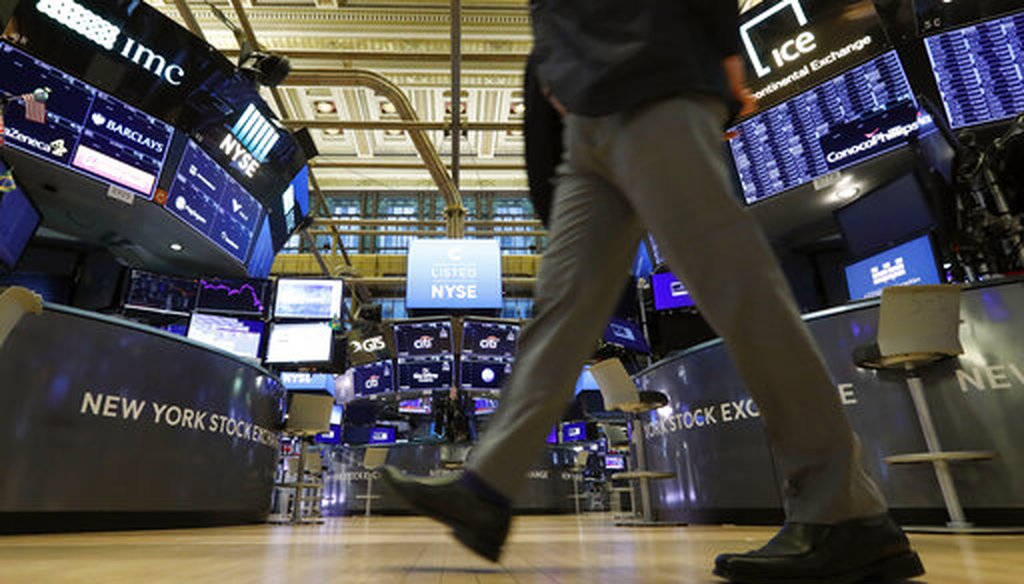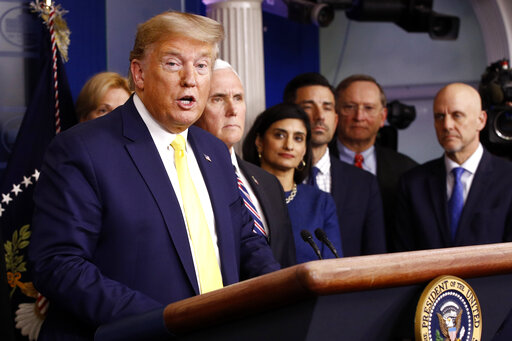Stand up for the facts!
Our only agenda is to publish the truth so you can be an informed participant in democracy.
We need your help.
I would like to contribute

A trader walks across the floor of the New York Stock Exchange on March 9, 2020. (AP/Drew)
If Your Time is short
-
The stock market took a major hit on March 9, with the Dow falling more than 2,000 points and the S&P 500 dropping so fast it triggered an automatic trading halt.
-
The turmoil came as traders reacted to the coronavirus outbreak and escalating tensions between Russia and Saudi Arabia over oil prices.
-
Experts said the economy could experience significant changes as the coronavirus continues to spread, and that investors should expect more market swings.
The stock market took a major hit on March 9, with the Dow Jones Industrial Average falling more than 2,000 points and the S&P 500’s early-morning plunge triggering an automatic, 15-minute trading halt known as a circuit breaker.
The market troubles came as traders, already on edge over the spreading coronavirus, reacted to escalating tensions between Russia and Saudi Arabia that led oil prices to suffer their biggest single-day drop since the Gulf War in 1991, according to reports.
President Donald Trump weighed in with tweets that celebrated low gas prices, downplayed the coronavirus and blamed Russia, Saudi Arabia and the media for the market drop.
The markets rebounded when trading opened the following day. Here’s what else you need to know about the stock market drop on March 9, 2020:
Minutes after trading opened on Monday, the S&P 500 fell by 7% in a drop so sharp that it triggered an automatic, 15-minute trading halt known as a circuit breaker.
What began as a panic in the oil market shook up most of Wall Street by the time trading closed for the day. The Dow slid 2,013.76 points, or 7.79%, from the previous trading day’s close; the S&P 500 fell 225.81 points, or 7.6%; and the Nasdaq composite fell 624.94 points, or 7.29%.
For all three indexes, the sell-off marked the largest single-day point drop in history and the worst percentage slip since the 2008 financial crisis.
The turmoil came as talks among the world’s largest oil producers fizzled out over Russia’s refusal to back a proposal for nations to cut oil production.
The proposal was meant to keep oil prices stable amid shrinking energy demand brought on by the coronavirus outbreak, which has caused flight cancellations and factory slowdowns around the world and especially in China, the world’s largest importer of oil.
Russia would not agree to scale back its output, and Saudi Arabia responded over the weekend with a full-blown price war, slashing its oil prices in a bid to flood the market with cheap oil. That led oil prices to tumble in the biggest single-day decline since the Gulf War.
All that piled onto existing economic anxieties due to the coronavirus, which as of March 9 had infected 109,577 people across more than 100 countries, per the World Health Organization.
The coronavirus has taken sick or quarantining workers out of the office, rocked the travel and energy industries and slowed down companies that depend on China for manufacturing.
"These two whammies came at once," said Peter Ricchiuti, professor at Tulane University’s Freeman School of Business.
Trump spun the news on Twitter, noting that lowered gas prices would be "good for the consumer" and pinning the crash on the fallout between Russia and Saudi Arabia.
Saudi Arabia and Russia are arguing over the price and flow of oil. That, and the Fake News, is the reason for the market drop!
— Donald J. Trump (@realDonaldTrump) March 9, 2020
But while the oil tensions played a role, rising fear of the coronavirus and its potential impact on economic activity was the underlying and more likely cause of the March 9 stock market crash, said Gary Burtless, a senior fellow in economic studies at the Brookings Institution.
"Much of the drop in oil prices was spurred by energy traders’ fears of a drop in future economic activity arising from the disruption caused by the coronavirus," Burtless said.
"With each wave of outbreak, people who maybe weren’t taking it seriously do take it seriously," added Kathleen Day, professor at the Johns Hopkins Carey Business School and author of a book on financial crises.
Day said no one ever knows with complete certainty why the stock market moves, noting that the biggest hits to the economy tend to have compounding causes, and that the Trump administration has rolled back certain financial safeguards and regulations.
"Even without the coronavirus, even without a war between Putin and Saudi Arabia, there were already signs the economy was maybe softening," she said.
The stock-market drop began shortly after trading opened, with the S&P 500’s losses reaching 7% roughly five minutes in, according to the New York Times.
The 7% drop set off a 15-minute, mandatory market halt known as a circuit breaker, which is meant to prevent panic selling that would lead to even steeper declines in small time frames.
According to the New York Stock Exchange, the first circuit breaker automatically kicks in for 15 minutes if declines reach 7% over the previous day. The second circuit breaker pauses trade for 15 minutes if they reach 13%. And the third ends all trade for the day if the drop hits 20%.
"The reason for circuit breakers and why you stop trading temporarily is all psychological," Day said. "Circuit breakers are a way to say, ‘Calm down, everybody.’ "
The earliest circuit breakers were put in place after a major stock market crash in October 1987, and they were later revamped in 2010 after they failed to prevent another crash.
March 9 was the first time the current circuit breakers, which went into effect in 2013, had been triggered during regular trading hours, according to CNBC. Burtless said they seemed to work as intended, since orderly trades resumed after the halt.
Still, the White House has faced pressure to reassure the markets and calm concerns that the economy could be tilting toward a recession.

President Donald Trump speaks about the coronavirus outbreak at the White House in Washington on March 9, 2020. (AP/Semansky)
The Federal Reserve had already made an emergency cut to the benchmark U.S. interest rate, and Trump signed an $8.3 billion aid package to combat the spread of the new coronavirus.
On March 9, the Fed announced it would increase the amount of money it offers to banks for short-term funding, and Trump said he would ask Congress to temporarily cut payroll taxes, provide relief for hourly workers and offer assistance to travel-related industries.
But Ricchiuti said the U.S. has "few weapons left to boost the economy and the stock market."
"As for monetary stimulus, how much lower can the Fed push down interest rates?" he said. "They’re basically out of ammo."
"For fiscal stimulus, the U.S. owes too much money," he added. "And the federal deficit is about $1 trillion annually."
Investors can expect more such swings in the near future as the coronavirus continues to take its toll on people and the economy, experts told us.
Burtless said that when stocks drop dramatically, there are often large single-day swings in both directions — on the way down and in the early recovery.
"Small changes in the outlook can have outsize effects on some traders’ expectations about the future," he said. "Investors should probably anticipate that there will be many days in the next weeks and months with big one-day changes."
Day said she expects "many more swings" due to economic and political uncertainties, but just how many depends on how investors react to developments with the coronavirus outbreak.
"I think the stock market will go up and down more," she said. "But as an investor, you can’t react to it every day."
The silver lining, Ricchiuti said, is that consumers can take advantage of low interest rates and cheap prices at the gas pump.
But day-to-day life for working people could change as more people across the globe decide to work from home and more business activities go remote. A number of American companies have already told employees to work from home.
Some companies could discover that remote work doesn’t hurt productivity and decide to cut down on face-to-face meetings or office space going forward, Day said.
Other companies could reap benefits from consumers staying indoors, such as Netflix at the expense of movie theaters or delivery services at the expense of grocery and retail stores.
"Some things you can’t replace," Day said. "But because of the internet, some of the economic impact of this is going to be blunted."
Our Sources
Yahoo Finance, Historical Dow Jones Stock Closings, accessed March 10, 2020
Yahoo Finance, Historical S&P 500 Stock Closings, accessed March 10, 2020
Yahoo Finance, Historical Nasdaq Composite Stock Closings, accessed March 10, 2020
The New York Stock Exchange, "Trading Information," accessed March 10, 2020
The World Health Organization, "Coronavirus disease 2019 (COVID-19) Situation Report – 49," March 9, 2020
Nasdaq, "Stock Market Crash 2020: Everything You Need to Know," March 10, 2020
MarketWatch, "Dow gains nearly 1,200 points after worst day since 2008 crisis," March 10, 2020
C-Span, "Coronavirus Task Force Briefing," March 9, 2020
The New York Times, "Stocks Plunge in Worst Drop Since 2008," March 9, 2020
Business Insider, "Oil is down 21% after its biggest drop in decades following Saudi price cuts that sparked a race to the bottom with Russia," March 9, 2020
CNN, "Why oil prices are crashing and what it means," March 9, 2020
Yahoo Finance, "Oil Plunges Most Since 1991 After Producers Embark on Price War," March 9, 2020
The Wall Street Journal, "Stocks Fall More Than 7% in Dow’s Worst Day Since 2008," March 9, 2020
CNBC, "Fed to step up cash injections for banks to guard against market pressure," March 9, 2020
CNBC, "The market triggered a ‘circuit breaker’ that kept stocks from falling through the floor. Here’s what you need to know," March 9, 2020
CNBC, "Dow sinks 2,000 points in worst day since 2008, S&P 500 drops more than 7%," March 8, 2020
Donald J. Trump on Twitter, March 9, 2020
Donald J. Trump on Twitter, March 9, 2020
Donald J. Trump on Twitter, March 9, 2020
CNBC, "Trump signs $8.3 billion emergency coronavirus spending package," March 6, 2020
NPR, "Amazon, Facebook, Google, Microsoft Tell Seattle Workers To Stay Home," March 5, 2020
The Washington Post, "Fed makes largest emergency cut to interest rates since the financial crisis," March 3, 2020
CNBC, "iPhone manufacturing in China is in limbo amid coronavirus outbreak," Feb. 10, 2020
The Washington Post, "Trump signs law rolling back post-financial crisis banking rules," March 24, 2018
Phone interview with Kathleen Day, professor at the Johns Hopkins Carey Business School and author of a book on financial crises, March 9, 2020
Email interview with Gary Burtless, senior fellow in economic studies at the Brookings Institution, March 9, 2020
Email interview with Peter Ricchiuti, professor at Tulane University’s Freeman School of Business, March 9, 2020
























